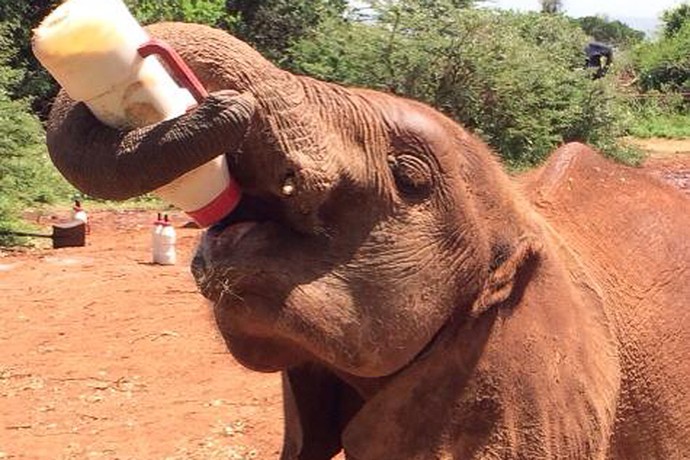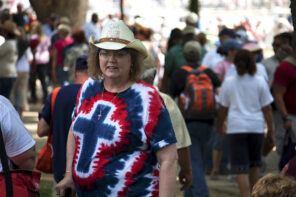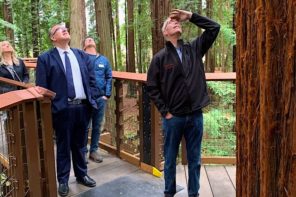It is a mild Kenyan day in January of 2014. With temperatures in the 70s. I smile with some Lutheran guilt because I know I am missing the worst of Minnesota’s frosty brunt of the so-called “polar vortex” (climate change in action). At this moment, instead of curling up with blankets and hot cocoa, I stand with nearly a hundred others outside in a large half-circle, leaning with anticipation against a waist-high rope. The crowd’s eyes are set on a dusty red trail emerging from a row of trees far on the other side. Cameras begin to click, small gasps and “awws” begin to rumble, and, from the crowd’s sudden muttering and questions, it becomes very clear to me that I have stumbled half hazardly across a kind of spiritual pilgrimage site.
We stand near a suburb of Nairobi known simply as “Karen,” named for the Danish immigrant who once had a farm here early in the 20th century. Most people in the U.S. know its namesake Karen Blixen in the guise of Meryl Streep, who portrayed Blixen in the award-winning film Out of Africa, based on Blixen’s own writings. And Blixen, of course, went by a number of famous pen names—Isak Dinesen is one—writing some of the most fascinating and beautiful theological stories of her time. Most notable is Babette’s Feast. But her theology is for another moment.
Today, Karen and its surrounding area is filled with shops, schools, and wildlife conservation areas. Kenya’s first national park is around the corner. My strange assembly of visitors from all over the world now gathers at the Elephant Orphanage and nursery in Nairobi National Park. The internationally renowned orphanage, associated with The David Sheldrick Wildlife Trust and the Kenya Wildlife service, has successfully rescued over 150 orphaned baby elephants and the occasional baby rhino, reintroducing them back to the wild of Tsavo East National Park. Many people now know of the nursery through the extraordinary work of Dr. Dame Daphne Sheldrick and her 2012 memoir, Love, Life, and Elephants: An African Love Story.
Once a day, strictly between the hours of 11AM and 12PM, the orphanage opens to the public for a visitor’s fee of 500 Kenyan shillings (a little under six U.S dollars at the moment). That strict time is a kind of compromise—a minimal amount of human contact for the orphans so the orphanage can raise some necessary funds for their care. The human animals arrive, line up, pay their dues, at eleven the crowd is let in, and the waiting begins.
And so we wait at the rope line. I recognize accents from the U.S. south, Denmark, the UK, Australia. Most are white, Western tourists. Some missionaries. A documentary film crew is here setting up a camera behind me that puts my iPhone to shame. Before us are pools of water, shrubbery, and larger bottles filled with a vegetable milk mixture. Suddenly, ten to fifteen baby elephants—the first group—come running down the hill for their food and bottles. It is seriously cute. And the crowd gasps and coos and takes as many pictures as they can manage.
The orphaned elephants grab their bottles with their trunks, guzzling every last drop. They roll in the mud. They drink water. And their caretakers offer them leaves and their milk solution. They run along the rope and the tourists grow silent as they pet the curious pachyderms—a kind of awe at the ordinary life of these animals. One of the calves makes a grab with her trunk at the television crew’s camera hovering over her, just barely missing. The crowd giggles. A caretaker in a bright green jacket advises us not to place our hands in the elephants’ mouth, because, he laughs, “elephants have teeth.”
Another caretaker takes to a microphone to explain how the thirty or so elephants they watch over at the moment landed there. One was simply found wandering. One caught in a snare. One mother is simply missing. Many of them orphaned victims of the ivory trade and poaching. The list is heartbreaking. The juxtaposition of the mental images of the history of suffering alongside the showy vision of playfulness before me is awkward to process. The first group leaves and a second group of about fifteen calves arrives.
My hand is now on the muddied forehead of an elephant, two years of age. The leathery texture of the orphan’s skin, her bright eyes communicate, perhaps deceivingly, a strange sort of innocence. Her mother was found slaughtered—the newly-alone standing vigil over the body. That is where they found her.
Despite a very recent concern about their endangerment, the systematic destruction of elephants is not a new phenomenon, however. Varieties—North African, Syrian, etc.—all went extinct at the hands of ancient humans far before the modern era. And the demand for ivory, whether for religious or spiritual or aesthetic reasons, doesn’t seem to be going away anytime soon. In a history of millennia of the destruction of elephants, saving a few hundred seems utterly insignificant. Yet, I remind myself, fragments of care quite often become the sources for deep hope, deep societal change.
The floor opens to questions from the crowd and the questions pour out—not about poaching or the ivory trade, but a list of questions that I might very likely hear in any one of the courses I teach on religion:
“I hear elephants have incredible memory—how does that work?”
“I hear they have rituals for how they bury the dead?”
“How do they mourn?”
“How do they play?”
“How are their communities, herds organized? I hear they rely on matriarchs?”
“I’ve heard stories that the orphans now in the wild in Tsavo just know when you’re releasing one back into the wild. And that it’s a mystery how they know. Could you talk about that mystery?”
“What about their emotions? I’ve read they can feel positive and negative energy you give off towards them.”
The caretaker assents that these stories are all, in some way, true.
I’m taken aback by the positive nature of the questions, their optimism, their interest in the minds, rituals, emotions, mysteries of these creatures.
I guess I shouldn’t be too surprised. A large number of the “spiritual but not religious” crowd in the West are self-proclaimed ecologists or naturalists. A large number of atheists and agnostics are deeply passionate about ecological ethics, or how we might be more “in tune” with nature. Culturally, they become fascinated in the personalities of cats and cat videos, the companionship of dogs who offer a kind of faithfulness no longer present even among the faithful. They ask about the complex emotional lives of orcas and the communication of dolphins. They gesture towards possible spiritualities and humanisms among chimps and apes, like primatologists Jane Goodall and Frans de Waal, respectively. They ask about forest restoration and global warming and water scarcity.
We could most certainly add elephants to this mix, but, in doing so, spiritual or ethical edification doesn’t and shouldn’t come easy. I doubt the ecological world, as it is often imagined, offers a “pure” kind of spiritual or moral vision or that any kind of fellow animal offers an easily translatable spirituality or morality for humans. Neither denigration nor idealization of our fellow creatures does us any good. Standing here, I recall a portion of the Kenyan writer Binyavanga Wainaina’s satirical essay about Western writers, “How to Write About Africa.” He mocks the common sketch of elephants: “Elephants are caring, and are good feminists or dignified patriarchs. So are gorillas. Never, ever say anything negative about an elephant or a gorilla. Elephants may attack people’s property, destroy their crops, and even kill them. Always take the side of the elephant.” It’s a complicated relationship to say the least. Especially when so many elephants get killed in the aftermath of such conflict.
But that doesn’t mean we can’t learn anything from other creatures, for inquiring into the complex possibility of ecological spiritualities and humanisms might be morally creative and productive—not least in that they confront us with the complicated histories and legacies of the human animal. Caitrin Nicol’s stunning recent essay in The New Atlantis, “Do Elephants Have Souls?”, is an incredible wrestling with such questions. She asks, “Whether there are millions or just one, what does it mean that there is such a thing as Elephant?”
Nicol’s writing meditates on the mystery, peaceable natures, and very real agencies and histories of these creatures. Such meditation calls into question the strange lines between what we define as “human” and “nonhuman.” And so perhaps the concrete histories and personalities of these elephants might haunt us a bit. Perhaps their rituals and communities and herds might inquire into our rituals and communities and human migrations. Perhaps a mutual inquiry into animal spiritualities, spirits, and morality might confront us all the more with our own unexamined anthropocentrisms.
Fellow creatures like these orphaned elephants—as they live their early lives across the messy and blurry lines of domestic and wild, human and nonhuman, dying and murdered, resilient and living—confront us with ecological histories known and unknown. They confront us with our living desires; they confront us with what we as humans, somehow complicit, have done to them. They sometimes confront us with ourselves in a kind of nonviolent resistance (at least in this case). They sometimes pose dangers in their wildness. They sometimes exhibit remarkable empathy for humans in their wildness. They complicate and indict our lives and the lives of those who have gone before us. And they cause us to ask what healing looks like structurally for our inter-species relationships.
At least two such complications continue to swirl in my mind today: that ecological spirituality is not innocent and cannot escape the messy violence of humans in the Anthropocene. And even where we might discern or intuit a kind of animal spirituality, emotion, ritual, memory—or a primordial binding of a kind of religious culture—those moments are utterly implicated in a human spiritual history of poaching, ivory trade, colonialism, human-wildlife farm conflicts, and big game hunting in Africa.
With my hand still resting on this young elephant’s coarse skin, her forehead pressing into my palm, I cannot help but reply under my breath, knowing it cannot be the final question, “What right do we have to learn from you?” And yet the demand is that we must in the catastrophe of our contemporary moment.





